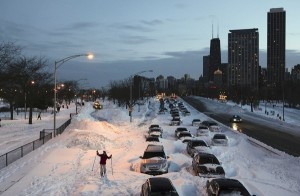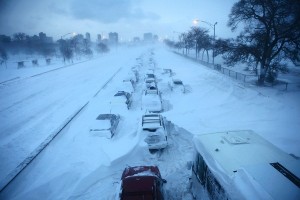It’s not often that my home street turns into a scene from the 1995 natural disaster film “The Day after Tomorrow.” Ok, it’s actually not any day in which that occurs. Until Tuesday. When all the snows settles, and gets shoveled the great Middle-American blizzard of 2011 will be known (in Chicago at least) as the “Lake Shore Drive Blizzard.”
Paper Lace had a hit 70s song “The Night Chicago Died,” this February 1st, 2011 was the night traffic of Chicago’s most famous street died. Like the Twitter hashtag all I can say is: #snOMG!
Here’s more from NBC Chicago.com
“I got 100 feet, everything was an orange hue, there was snow in my face, I couldn’t see anything, I turned around and couldn’t see the bus and I thought I was going to die,” she said Wednesday morning.
Wilson was among hundreds of people in at least 1,500 vehicles who found themselves trapped on Chicago’s most famous stretch of road for as long as 12 hours Tuesday night and Wednesday morning during one of the worst snow storms in the city’s history.
The situation was among the worst impacts from the winter storm that carved a frigid path along a 2,100-mile stretch across the eastern U.S….
…Three lanes of cars cluttered the road with snow reaching as high as the windshields. Some cars were almost completely buried. Bulldozers worked to clear the snow from around the cars, then tow trucks plucked them out of snow drifts one by one.
The stranded vehicles were the worst breakdown in Chicago’s handling of the storm.
Some motorists came away angry, frustrated and puzzled at why the city didn’t close the crucial thoroughfare earlier, or why officials didn’t anticipate that a bus accident could clog it up like a cork in a bottle.
And the aftermath from the Chicago Tribune:
Chicago officials say they will “work into the night” to clear stranded cars and buses from Lake Shore Drive and reopen the highway that’s been closed since the brunt of the blizzard hit Tuesday night.
But Ray Orozco, Mayor Richard Daley’s chief of staff, acknowledged the job is daunting, noting that about 200 vehicles remained mired in snow drifts as of 4 p.m. There were also a number of stuck CTA buses.
While city officials hope to have a clearer picture later tonight, Orozco acknowledged the pace of towing on the drive would need to pick up considerably for the road to be open Thursday morning.
Orozco said he still believes keeping the drive open was the right decision, pointing to the fact emergency crewsd would have had a difficult time responding to calls if the arterial streets had been clogged with traffic.
He also said he felt it was important to keep the drive open as long as possible because thousands of commuters depended on it to get home.
Hundreds of motorists and CTA passengers ended up trapped on the drive for six hours or more Tuesday night. Many were not rescued until early this morning, as rescue workers battled white-out conditions, 70 mph wind gusts and waist-high drifts to provide help.
City officials, however, said they had cautioned people in news conferences earlier Tuesday that massive waves along the shoreline could cause extremely icy conditions on the drive. Authorities, however, did not officially close the road until 8 p.m., after a series of accidents caused motorists and several CTA buses to become stuck.

